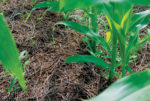Advertise Follow Us
No-Till Farmer

View Archived Issues
September 2016
Volume: 45
Edition: 9
Get full access NOW to the most comprehensive, powerful and easy-to-use online resource for no-tillage practices. Just one good idea will pay for your subscription hundreds of times over.
-
Table of Contents
Table of Contents
Digital Subscribers enjoy full access to No-Till Farmer's premium content. A paid subscription is required in order to read these stories.Are you a Premium or Digital subscriber? You enjoy:
- Unlimited access to all digital content here
- Freedom to view No-Till Farmer on all your devices
- Gleaning years of knowledge from the world's largest online library dedicated to no-till practices
Are you a Print only subscriber? Easily upgrade your subscription today! For only $10 more on a one year option, you gain the benefits of both the print edition delivered to your door and unlimited access to thousands of online pages of no-till content.
Lower C:N Ratios, Termination Determine Nitrogen from Covers
A certified crop advisor and agronomist explains how choosing the right species and promoting its growth can help no-tillers acquire free nitrogen from their cover crops.Read MoreWhat I've Learned from No-TillingManaging Soil Conditions and Plant Health Keeps Yields Climbing
Constant experimentation and evaluation of his no-till equipment and products help Keavin Hill weed out what really works for his farm.Read MoreWhat Crop Rotation Can Do for Soil Biology
A soil biologist explains how a high ‘diversity index’ of cash crops and covers unlocks soil biology potential and increases the viability of no-till systems.Read MoreNo-Till and Cover Crops Fixing Soils, Protecting the Bay
Ronnie and Dwight Forrester are improving nutrient efficiency and soil health on their Virginia farm with variable-rate fertilizer applications and diverse cover-crop mixes.Read MoreNo Magic Formula for No-Till Success
Concentrating on 10 basic ideas while trimming back acres has helped veteran no-tiller Mike Wolpert enjoy more time with his family.Read MoreConservation Keeping Growers Competitive on Heavy, Wet Soils
The Baileys are seeing yields comparable to their conventional tillage neighbors with no-till while protecting soil and saving on additional equipment expenses.Read MoreGetting a Grip on Palmer Amaranth
Residual herbicides, intensive scouting and timely post control are crucial to prevent this voracious weed from taking over no-tilled fields.Read More -
Featured Articles
Featured Articles
Lower C:N Ratios, Termination Determine Nitrogen from Covers
A certified crop advisor and agronomist explains how choosing the right species and promoting its growth can help no-tillers acquire free nitrogen from their cover crops.Read MoreNo Magic Formula for No-Till Success
Concentrating on 10 basic ideas while trimming back acres has helped veteran no-tiller Mike Wolpert enjoy more time with his family.Read MoreGetting a Grip on Palmer Amaranth
Residual herbicides, intensive scouting and timely post control are crucial to prevent this voracious weed from taking over no-tilled fields.Read More - Digital Edition
- Online Extras












